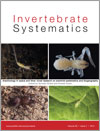Spiders in the subfamily Argyrodinae are known for their associations with other spiders. These associations include predation (araneophagy), web usurpation and kleptoparasitism. Although the majority of the 239 described species are solitary, ∼20 species live in groups in the webs of their hosts. We constructed a molecular phylogeny of argyrodine genera and species in order to investigate (1) the evolution of araneophagy and kleptoparasitism, and (2) group-living and its association with particular types of host webs. We investigated the phylogeny of 41 primarily Asian and American species representing six recognised genera of Argyrodinae, using sequences of four genes: mitochondrial cytochrome c oxidase I (COI) and 16S rRNA (16S); and nuclear 28S rRNA (28S) and histone 3 (H3). We used Bayesian methods to reconstruct the ancestral states of three behavioural characters: foraging method, group-living and specialisation on large webs of large hosts. We tested for correlated evolution of group-living behaviour and specialisation on large webs using reversible-jump Markov chain Monte Carlo methods. The molecular phylogenetic analyses support the monophyly of the Argyrodinae. Reconstruction of ancestral states shows the evolutionary pathway of web-invading behaviour in Argyrodinae is from araneophagy to kleptoparasitism, and then to group-living kleptoparasitism. We found the evolution of group-living behaviour is strongly correlated with specialisation on the use of large host webs, which provide a larger food resource than smaller webs.
How to translate text using browser tools
12 September 2014
Evolution of host use, group-living and foraging behaviours in kleptoparasitic spiders: molecular phylogeny of the Argyrodinae (Araneae : Theridiidae)
Yong-Chao Su,
Deborah Smith
ACCESS THE FULL ARTICLE

Invertebrate Systematics
Vol. 28 • No. 4
September 2014
Vol. 28 • No. 4
September 2014
araneophagy
correlated character evolution
kleptoparasitism
sociality




